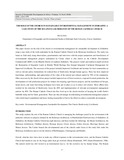Please use this identifier to cite or link to this item:
https://cris.library.msu.ac.zw//handle/11408/1118Full metadata record
| DC Field | Value | Language |
|---|---|---|
| dc.contributor.author | Jerie, Steven | - |
| dc.date.accessioned | 2016-04-28T09:00:24Z | - |
| dc.date.available | 2016-04-28T09:00:24Z | - |
| dc.date.issued | 2010 | - |
| dc.identifier.issn | 1520-5509 | - |
| dc.identifier.uri | http://www.jsd-africa.com/Jsda/Vol12No8_Winter2010_B/PDF/The%20Role%20of%20the%20Church%20in%20Sustainable%20Environment.pdf | - |
| dc.description.abstract | This paper focuses on the role of the church in environmental management for sustainable development in Zimbabwe using a case study of the work undertaken by the Roman Catholic Church in the Bulawayo Archdiocese. The study was based on field study using observations, questionnaires and interviews with the project proponents and beneficiaries of environmental management projects undertaken by Caritas which is also known as the Catholic Development Commission(CADEC) in the Matobo District of southern Zimbabwe. The projects visited and studied in depth involved the Restoration of Degraded Lands in Matobo World Heritage Site through Integrated Catchment Management for Improved Livelihoods. The successes of the project included improved livelihoods and incomes for local communities as well as relevant policy formulations for reduced loss of biodiversity through human agency. There has been improved knowledge, understanding, and appreciation of the value of the natural and cultural capital by 70% of the community. Other successes by the church driven project include improved use of forest resources, crop and livestock production, the development of craft production projects for women, bee keeping, agro-forestry projects, and the installation of bio-gas, bread stoves, and water harvesting techniques have been put in place so as to reduce soil erosion. These efforts have resulted in the reduction of biodiversity losses by 40% and implementation of relevant environmental management policies by 40%. The Roman Catholic Church has thus lived up to the church doctrine of keeping the Lord’s Earth’s habitable today and for future generations. There are thus advantages in undertaking environmental management projects with a faith based commitment and hence feeling responsible to God in the efforts to achieve sustainable development. | en_US |
| dc.language.iso | en | en_US |
| dc.relation.ispartofseries | Journal of Sustainable Development in Africa;Vol. 12, no.8 | - |
| dc.subject | Environmental Management | en_US |
| dc.subject | Sustainable Development; | en_US |
| dc.subject | Sustainable Development | en_US |
| dc.subject | The Church | en_US |
| dc.subject | Biodiversity | en_US |
| dc.subject | Livelihoods | en_US |
| dc.title | The role of the church in sustainable environmental management in Zimbabwe: a case study of the Bulawayo Archdiocese of the Roman Catholic Church | en_US |
| dc.type | Article | en_US |
| item.grantfulltext | open | - |
| item.openairecristype | http://purl.org/coar/resource_type/c_18cf | - |
| item.cerifentitytype | Publications | - |
| item.fulltext | With Fulltext | - |
| item.languageiso639-1 | en | - |
| item.openairetype | Article | - |
| Appears in Collections: | Research Papers | |
Files in This Item:
| File | Description | Size | Format | |
|---|---|---|---|---|
| The Role of the Church in Sustainable Environment.pdf | 70.9 kB | Adobe PDF |  View/Open |
Page view(s)
20
checked on Jul 26, 2024
Download(s)
4
checked on Jul 26, 2024
Google ScholarTM
Check
Items in MSUIR are protected by copyright, with all rights reserved, unless otherwise indicated.


